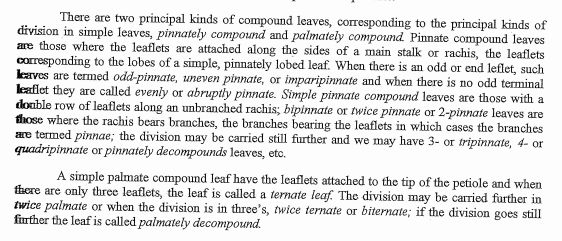There are two principal kinds of compound leaves, corresponding to the principal kinds of division in simple leaves, pinnately compound and palmately compound Pinnate compound leaves are those where the leaflets are attached along the sides of a main stalk or rachis, the leaflets corresponding to the lobes of a simple, pinnately lobed leaf. When there is an odd or end leflet, such kaves are termed odd-pinnate, uneven pinnate, or imparipinnate and when there is no odd terminal leaflet they are called evenly or abruptly pinnate. Simple pinnate compound leaves are those with a double row of leaflets along an unbranched rachis; bipinnate or twice pinnate or 2-pinnate leaves are those where the rachis bears branches, the branches bearing the leaflets in which cases the branches ae termed pinnae; the division may be carried still further and we may have 3- or tripinnate, 4- or quadripinnate or pinnately decompounds leaves, etc. A simple palmate compound leaf have the leaflets attached to the tip of the petiole and when there are only three leaflets, the leaf is called a ternate leaf. The division may be carried further in twice palmate or when the division is in three's, twice ternate or biternate; if the division goes still firther the leaf is called palmately decompound.
There are two principal kinds of compound leaves, corresponding to the principal kinds of division in simple leaves, pinnately compound and palmately compound Pinnate compound leaves are those where the leaflets are attached along the sides of a main stalk or rachis, the leaflets corresponding to the lobes of a simple, pinnately lobed leaf. When there is an odd or end leflet, such kaves are termed odd-pinnate, uneven pinnate, or imparipinnate and when there is no odd terminal leaflet they are called evenly or abruptly pinnate. Simple pinnate compound leaves are those with a double row of leaflets along an unbranched rachis; bipinnate or twice pinnate or 2-pinnate leaves are those where the rachis bears branches, the branches bearing the leaflets in which cases the branches ae termed pinnae; the division may be carried still further and we may have 3- or tripinnate, 4- or quadripinnate or pinnately decompounds leaves, etc. A simple palmate compound leaf have the leaflets attached to the tip of the petiole and when there are only three leaflets, the leaf is called a ternate leaf. The division may be carried further in twice palmate or when the division is in three's, twice ternate or biternate; if the division goes still firther the leaf is called palmately decompound.
Human Anatomy & Physiology (11th Edition)
11th Edition
ISBN:9780134580999
Author:Elaine N. Marieb, Katja N. Hoehn
Publisher:Elaine N. Marieb, Katja N. Hoehn
Chapter1: The Human Body: An Orientation
Section: Chapter Questions
Problem 1RQ: The correct sequence of levels forming the structural hierarchy is A. (a) organ, organ system,...
Related questions
Question
According to the text, What is compound leaves are in these figures?


Transcribed Image Text:There are two principal kinds of compound leaves, corresponding to the principal kinds of
division in simple leaves, pinnately compound and palmately compound Pinnate compound leaves
are those where the leaflets are attached along the sides of a main stalk or rachis, the leaflets
corresponding to the lobes of a simple, pinnately lobed leaf. When there is an odd or end leflet, such
kaves are termed odd-pinnate, uneven pinnate, or imparipinnate and when there is no odd terminal
leaflet they are called evenly or abruptly pinnate. Simple pinnate compound leaves are those with a
double row of leaflets along an unbranched rachis; bipinnate or twice pinnate or 2-pinnate leaves are
those where the rachis bears branches, the branches bearing the leaflets in which cases the branches
ae termed pinnae; the division may be carried still further and we may have 3- or tripinnate, 4- or
quadripinnate or pinnately decompounds leaves, etc.
A simple palmate compound leaf have the leaflets attached to the tip of the petiole and when
there are only three leaflets, the leaf is called a ternate leaf. The division may be carried further in
twice palmate or when the division is in three's, twice ternate or biternate; if the division goes still
firther the leaf is called palmately decompound.
Expert Solution
This question has been solved!
Explore an expertly crafted, step-by-step solution for a thorough understanding of key concepts.
Step by step
Solved in 3 steps with 1 images

Knowledge Booster
Learn more about
Need a deep-dive on the concept behind this application? Look no further. Learn more about this topic, biology and related others by exploring similar questions and additional content below.Recommended textbooks for you

Human Anatomy & Physiology (11th Edition)
Biology
ISBN:
9780134580999
Author:
Elaine N. Marieb, Katja N. Hoehn
Publisher:
PEARSON

Biology 2e
Biology
ISBN:
9781947172517
Author:
Matthew Douglas, Jung Choi, Mary Ann Clark
Publisher:
OpenStax

Anatomy & Physiology
Biology
ISBN:
9781259398629
Author:
McKinley, Michael P., O'loughlin, Valerie Dean, Bidle, Theresa Stouter
Publisher:
Mcgraw Hill Education,

Human Anatomy & Physiology (11th Edition)
Biology
ISBN:
9780134580999
Author:
Elaine N. Marieb, Katja N. Hoehn
Publisher:
PEARSON

Biology 2e
Biology
ISBN:
9781947172517
Author:
Matthew Douglas, Jung Choi, Mary Ann Clark
Publisher:
OpenStax

Anatomy & Physiology
Biology
ISBN:
9781259398629
Author:
McKinley, Michael P., O'loughlin, Valerie Dean, Bidle, Theresa Stouter
Publisher:
Mcgraw Hill Education,

Molecular Biology of the Cell (Sixth Edition)
Biology
ISBN:
9780815344322
Author:
Bruce Alberts, Alexander D. Johnson, Julian Lewis, David Morgan, Martin Raff, Keith Roberts, Peter Walter
Publisher:
W. W. Norton & Company

Laboratory Manual For Human Anatomy & Physiology
Biology
ISBN:
9781260159363
Author:
Martin, Terry R., Prentice-craver, Cynthia
Publisher:
McGraw-Hill Publishing Co.

Inquiry Into Life (16th Edition)
Biology
ISBN:
9781260231700
Author:
Sylvia S. Mader, Michael Windelspecht
Publisher:
McGraw Hill Education